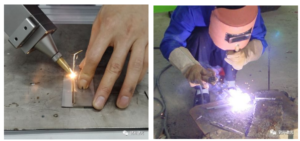Hand-held Laser Welding VS Traditional Electric Welding
What are the advantages of hand-held laser welding over traditional welding and laser welding?

|
|
|
|
|
|
|
|
|
|
|
|
|
|
|
|
|
|
|
|
|
|
|
|
|
|
|
|
More than 2times argonarc welding
|
More than 2times argonarc welding
|
|
|
Stainless Steel, Carbon Steel, Galvanized Sheet
|
Stainless Steel, Carbon Steel, Galvanized Sheet
|
Stainless Steel, Carbon Steel, Galvanized Sheet
|
|
|
|
|
|
|
|
|
|
|
|
|
|
|
|
|
|
|
|
|
|
|
|
|
|
|
|
|
|
|
|
|
|
|
|
|
|
|
|
|
In fact,in conventional laser vibration welding, the collimated beam is vibrated by a uniaxial galvanometer.
And the spot focused by the focusing mirror is moved with the welding head to move relative to the workpiece to form a weld having a certain amplitude, frequency and offset.
Besides, comparing to the first two vibration welding modes, the double wedge mirror rotational vibration welding produces a spiral weld seam.
By the vibration module mounted between the collimating mirror and the focusing mirror.
So that the focusing spot moves while the welding head moves.
When the focal length is the same, the larger the torsion angle is, the larger the vibration amplitude is.
Therefore, double wedge vibration welding allows the weld joint to be widened while achieving better weld formability.

